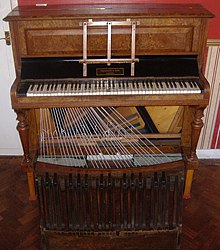Types
Modern pianos come in two basic configurations (with subcategories): the grand piano and the upright piano.
Grand
In grand pianos, the frame and strings are horizontal, with the strings extending away from the keyboard. The action lies beneath the strings, and uses gravity as its means of return to a state of rest.
There are many sizes of grand piano. A rough generalization distinguishes the concert grand(between about 2.2 m and 3 m/9.84 feet long) from the parlor grand or boudoir grand (about 1.7 m to 2.2 m) and the smaller baby grand (around 1.5 m).
All else being equal, longer pianos with longer strings have larger, richer sound and lowerinharmonicity of the strings. Inharmonicity is the degree to which the frequencies of overtones(known as partials or harmonics) sound sharp relative to whole multiples of the fundamental frequency. This results from the piano's considerable string stiffness; as a struck string decays, its harmonics vibrate not from their termination but from a point very slightly toward the center (or more flexible part) of the string. The higher the partial, the further sharp it runs. Pianos with shorter and thicker strings, i.e. small pianos with short string scales, have more inharmonicity. The greater the inharmonicity, the more the ear perceives it as harshness of tone.
Inharmonicity requires octaves to be "stretched", or tuned to a lower octave's corresponding sharp overtone rather than to a theoretically correct octave. If octaves were not stretched, single octaves would sound in tune, but double—and notably triple—octaves would be unacceptably narrow. When a small piano's octaves are stretched to match its inherent inharmonicity level, it creates an unacceptable imbalance among all the instrument's intervallic relationships, not just its octaves. But in a concert grand, the "stretch" of octaves retains harmonic balance even when aligning treble notes to a harmonic produced from three octaves below. This allows close and widespread octaves to sound pure, and enables perfect fifths (another interval that modern ears expect to be pure) to remain virtually beatless throughout the instrument's compass. This gives the concert grand a brilliant, singing and sustaining tone quality, one of the principal reasons that full-size grands are used in the concert hall, and smaller grands chosen for domestic use where space and cost are considerations.
Upright
Upright pianos, also called vertical pianos, are more compact because the frame and strings are vertical. The hammers move horizontally, and are returned to their resting position by springs, which are prone to wear and tear. Upright pianos with unusually tall frames and long strings are sometimes called upright grand pianos. Some authors classify modern pianos according to their height and to modifications of the action that are necessary to accommodate the height.
- Studio pianos are around 42 to 45 inches tall. This is the shortest cabinet that can accommodate a full-sized action located above the keyboard.
- Console pianos have a compact action (shorter hammers), and are a few inches shorter than studio models.
- The top of a spinet model barely rises above the keyboard. The action is located below, operated by vertical wires that are attached to the backs of the keys.
- Anything taller than a studio piano is called an upright.
Other types
Toy pianos began to be manufactured in the 19th century.
In 1863, Henri Fourneaux invented the player piano, which plays itself from a piano roll without the need for a pianist. A performance is recorded onto rolls of paper with perforations, and the player piano replays the performance using pneumatic devices. Modern equivalents of the player piano include the Bösendorfer CEUS and the Yamaha Disklavier, using solenoids and MIDI rather than pneumatics and rolls.
A silent piano is an acoustic piano having an option to silence the strings by means of an interposing hammer bar. They are designed for private silent practice.
The transposing piano was invented in 1801 by Edward Ryley. It has a lever under the keyboard used to move the keyboard relative to the strings so that a pianist can play in a familiar key while the music sounds in a different key.
The prepared piano, encountered in some contemporary art music, is a grand piano with objects placed inside it to alter its sound, or that has had its mechanism changed in some other way. The scores for music for prepared piano specify the modifications, for example instructing the pianist to insert pieces of rubber, or paper, or metal screws or washers, in between the strings. These either mute the strings or alter their timbre.
Available since the 1980s, digital pianos use digital sampling technology to reproduce the sound of each piano note. Digital pianos can be sophisticated, with features including working pedals, weighted keys, multiple voices, and MIDIinterfaces. However, when the damper pedal (see below) is depressed on such an instrument, there are no strings to vibrate sympathetically.Physical models of sympathetic vibration are incorporated into the synthesis software of some higher end digital pianos, such as the Yamaha Clavinova series, or the KAWAI MP8 series.
With the advent of powerful desktop computers, highly realistic pianos have become available as affordable software modules. Some of these modules, such as Synthogy's Ivory released in 2004, use multi-gigabyte piano sample sets with as many as 90 recordings, each lasting many seconds, for each of the 88 (some have 81) keys under different conditions, augmented by additional samples to emulate sympathetic resonance, key release, the drop of the dampers, and simulations of piano techniques like re-pedaling. Some other software modules, such as Modartt's Pianoteq released in 2006, use no samples whatsoever and are a pure synthesis of all aspects of the physicalities that go into the creation of a real piano's sound.
In recent times, piano manufactures have superseded the old fashioned pianola or player piano with new innovative pianos that play themselves via a CD or MP3 Player. Similar in concept to a player piano, the PianoDisc or iQ systems installed in select pianos will 'play themselves' when prompted by a certain file format designed to be interpreted by software installed and connected to the piano. Such additions are quite expensive, often doubling the cost of a piano and are available in both upright and grand pianos.
Keyboard
Further information: Musical keyboard
"Piano keys" redirects here. For the runway threshold markings, see Runway#Runway markings.
Almost every modern piano has 36 black keys and 52 white keys for a total of 88 keys (sevenoctaves plus a minor third, from A0 to C8). Many older pianos only have 85 keys (seven octaves from A0 to A7), while some manufacturers extend the range further in one or both directions.
Some Bösendorfer pianos, for example, extend the normal range down to F0, with one other model going as far as a bottom C0, making a full eight octave range. These extra keys are sometimes hidden under a small hinged lid that can cover the keys to prevent visual disorientation for pianists unfamiliar with the extra keys. On others, the colors of the extra white keys are reversed (black instead of white).
The extra keys are added primarily for increased resonance from the associated strings; that is, they vibrate sympathetically with other strings whenever the damper pedal is depressed and thus give a fuller tone. Only a very small number of works composed for piano actually use these notes. More recently, the Stuart and Sons company has also manufactured extended-range pianos, with the first 102 key piano. On their instruments, the frequency range extends from C0 to F8, which is the widest practical range for the acoustic piano. The extra keys are the same as the other keys in appearance.
Small studio upright acoustical pianos with only 65 keys have been manufactured for use by roving pianists. Known as gig pianos and still containing a cast iron harp, these are comparatively lightweight and can be easily transported to and from engagements by only two people. As their harp is longer than that of a spinet or console piano, they have a stronger bass sound that to some pianists is well worth the trade-off in range that a reduced key-set offers.
The toy piano manufacturer Schoenhut started manufacturing both grands and uprights with only 44 or 49 keys, and shorter distance between the keyboard and the pedals. These pianos are true pianos with action and strings. The pianos were introduced to their product line in response to numerous requests in favor of it.
Pedals
Standard pedals
Main article: Piano pedals
Pianos have had pedals, or some close equivalent, since the earliest days. (In the 18th century, some pianos used levers pressed upward by the player's knee instead of pedals.) Most grand pianos in the US have three pedals: the soft pedal (una corda), sostenuto, and sustain pedal (from left to right, respectively), while in Europe, the standard is two pedals: the soft pedal and the sustain pedal. Most modern upright pianos also have three pedals: soft pedal, practice pedal and sustain pedal, though older or cheaper models may lack the practice pedal. Again, in Europe the standard for upright pianos is two pedals: the soft and the sustain pedals.
The sustain pedal (or, damper pedal) is often simply called "the pedal", since it is the most frequently used. It is placed as the rightmost pedal in the group. It lifts the dampers from all keys, sustaining all played notes. In addition, it alters the overall tone by allowing all strings, even the ones not directly played, to reverberate.
The soft pedal or una corda pedal is placed leftmost in the row of pedals. In grand pianos it shifts the entire action/keyboard assembly to the right (a very few instruments have shifted left) so that the hammers hit two of the three strings for each note. In the earliest pianos whose unisons were bichords rather than trichords, the action shifted so that hammers hit a single string, hence the name una corda, or 'one string'. The effect is to soften the note as well as change the tone. In uprights this action is not possible; instead the pedal moves the hammers closer to the strings, allowing the hammers to strike with less kinetic energy. This produces a slightly softer sound, but no change in timbre.
On grand pianos, the middle pedal is a sostenuto pedal. This pedal keeps raised any damper already raised at the moment the pedal is depressed. This makes it possible to sustain selected notes (by depressing the sostenuto pedal before those notes are released) while the player's hands are free to play additional notes (which aren't sustained). This can be useful for musical passages with pedal points and other otherwise tricky or impossible situations.
On many upright pianos, there is a middle pedal called the "practice" or celeste pedal. This drops a piece of felt between the hammers and strings, greatly muting the sounds. Often this pedal can be shifted while depressed, into a "locking" position.
There are also non-standard variants. On some pianos (grands and verticals), the middle pedal can be a bass sustain pedal: that is, when it is depressed, the dampers lift off the strings only in the bass section. This pedal would be used only when a pianist needs to sustain a single bass note or chord over many measures, while playing the melody in the treble section. On the Stuart and Sons piano as well as the largestFazioli piano, there is a fourth pedal to the left of the principal three. This fourth pedal works in the same way as the soft pedal of an upright piano, moving the hammers closer to the strings.
Unusual pedals
The rare transposing piano, of which Irving Berlin possessed an example, has a middle pedal that functions as a clutch that disengages the keyboard from the mechanism, enabling the keyboard to be moved to the left or right with a lever. The entire action of the piano is thus shifted to allow the pianist to play music written in one key so that it sounds in a different key.
There were three piano companies to include extra pedals other than the standard two or three. Two of these companies offered a piano with four pedals (Crown and Schubert Piano Co.), and Wing and Son of New York offered a five pedal piano from approximately 1893 through the 1920s. There is no mention of the company past the 1930s. Labeled left to right the pedals are Mandolin, Orchestra, Expression, Soft, and Forte (Sustain). The Mandolin pedal produces a sound similar to a vibrato feel by bouncing a set of small hammers against the strings, enabling the piano to mimic a mandolin, guitar, banjo, zither and harp. The Orchestra (Orch) pedal used a similar approach, lowering a set of metal tipped felt strips in between the hammers and the strings. This extended the life of the hammers when the Orch pedal was used, a good idea for practicing, and created an echo-like sound that mimicked playing in an orchestral hall.[
The pedalier piano, or pedal piano, is a rare type of piano that includes a pedalboard, enabling bass register notes to be played with the feet, as is standard on the organ. There are two types of pedal piano: the pedal board may be an integral part of the instrument, using the same strings and mechanism as the manual keyboard, or, less frequently, it may consist of two independent pianos (each with its separate mechanics and strings), which are placed one above the other, a regular piano played by the hands and a bass-register piano played by the feet.



















0 comments:
Post a Comment